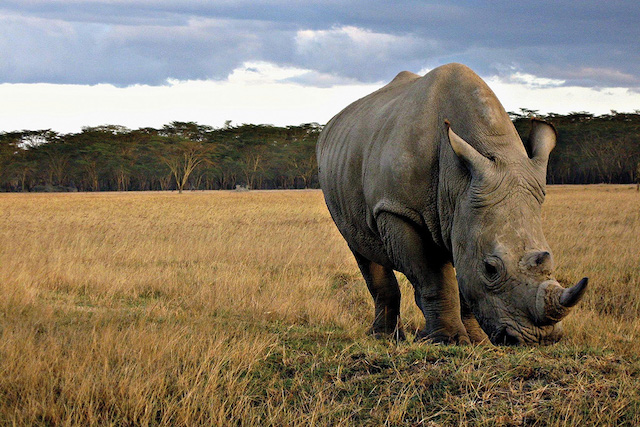As part of a holistic effort to reduce poaching, South Africa hosted its first legal auction of rhino horn in late August after a long campaign by wildlife owners to take trade in the prized commodity out of the black market. The auction was not without controversy. For nearly 30 years, nations and nongovernmental organizations have been struggling to find ways to make legal trade in high-value wildlife products sustainable and free of corruption.
Many in the international community have given up the search for solutions to poaching in favor of total trade bans. But the opening of a legal domestic trade in rhino horn in South Africa, coupled with the emergence of blockchain and other related technologies, offers Africans the possibility to fully benefit from their wildlife resources.
South Africa is home to more than 80 percent of the world’s southern white rhinoceros population. There are more southern white rhinos in South Africa today than there were in 1970—roughly 12,000 more based on current population estimates, with one quarter of those located on private land. This rebound is in large part due to the widespread privatization of rhinos that began in 1968, along with the creation of incentives for rhino conservation that resulted from resuming live sales and regulated hunting of the animal in the late 1960s and early 1970s.
Despite this growth, South Africa has not escaped the continent’s widely publicized rhino-poaching crisis, which stems from Asian demand for the animal’s horn. While rhino horn is a renewable resource that can be removed safely and humanely without harming the animal, the end result of poaching is usually a dead rhino. Poachers typically have no qualms about using hasty and brutal means, and their methods generally involve bullets instead of tranquilizers.
It would be possible to use a rhino’s DNA barcode as the unit recorded by a blockchain. Such a system would keep account of rhino horns within the legal market.
Rhinoceros are a high-value wildlife species that also bring high maintenance costs. While a live rhino can be bought in South Africa for the equivalent of roughly $27,000, owners must also contend with upkeep expenses such as veterinary care and private security. In response to increases in rhino poaching, many landowners have resorted to fielding their own anti-poaching guards or employing private security firms to safeguard the animals they steward. According to reports from conservancy owners, such security can cost an operator more than half a million dollars per year. This significant additional cost has had an expected effect: It has decreased the economic competitiveness of rhino conservation on private lands in South Africa, threatening the nation’s southern white rhino recovery.
Rather than turn their backs on the rhino, South African landowners proposed domestic legalization of the rhino-horn trade, envisioning that the funds raised would be used to offset the ballooning costs of conservation. The government granted their wish when it legalized trade in rhino horn earlier this year. The hope is that by maximizing the value of live rhinos to landowners and creating another rhino-based revenue stream, incentives to conserve the animal will be preserved.
Under draft regulations issued in July by the South African government, only trade in whole horns will be allowed, and horns can only be exported for non-commercial uses. Horns for export will also be subject to DNA tests and contain a microchip and serial number as well as the appropriate permit under the Convention on International Trade in Endangered Species.
Whether this is enough to safeguard the integrity of the market and the security of rhino populations is yet to be seen. However, opportunities exist to leverage existing technologies to strengthen South Africa’s rhino-horn trading system and create a sustainable and thriving marketplace. Combining DNA indexing systems with a blockchain, for instance, would allow for legally acquired rhino horns to be traded and tracked through an unalterable ledger, thereby limiting opportunities for illicitly obtained horns to enter the system. Such a framework would also safeguard buyers from future claims that they have acquired poached horns.
Rhino DNA indexing systems, like the RhODIS project launched by the Veterinary Genetics Laboratory of the University of Pretoria, are already in use in South Africa. These systems differentiate between legally and illegally acquired rhino horns in government stockpiles. Integrating them into the wider domestic market would allow horns to be made available for legal sale. The indexing works by scoring a unique genetic fingerprint for each rhino, using DNA sequences from each animal. This in turn produces a unique “barcode” for each rhino. The system is sound enough that its records have been successfully used in court cases brought against illicit wildlife traffickers.
Blockchains are also becoming more common, most notably as a core component of the digital currency Bitcoin, but also in efforts to register land titles in countries from Ghana to Sweden. At its most basic level, a blockchain is a constantly evolving ledger of records that are secured cryptographically. It functions as a distributed ledger capable of durably and verifiably recording transactions via a peer-to-peer network with established protocols for validating new records. Each record, or “block,” is linked to a previous record along with a timestamp and transaction data. Once recorded, a block is impossible to alter without changing all subsequent blocks, which would require the consent of the entire peer-to-peer network, meaning the system is extremely difficult to corrupt.
It would be possible to use a rhino’s DNA barcode as the unit recorded by a blockchain. Such a system would keep account of rhino horns within the legal market, as well as the identities of buyers and sellers. Theoretically, this approach could be applied not only to whole, raw horns but also to value-added products like Jambiya daggers favored in parts of the Arab world and antique objets d’art, since the weight of horn relative to each barcode could be captured within the ledger. This would have the effect of reducing marketplace porousness with regard to illicitly acquired horn. It would also allow law enforcement agencies to focus their resources more effectively while providing wildlife owners an additional source of income to fund security programs that deter poaching.
With the resumption of legal sales of rhino horn, South Africa has taken a bold and necessary step in the effort to deter poaching and support rhino conservation by maximizing the economic value these animals hold. The task now is to structure the trade in such a way that it achieves its stated conservation goals and does not add to or exacerbate the challenges it seeks to overcome. DNA indexing and blockchain technologies together hold part of the answer to the question of how to make trade in rhino horn sustainable, making it much more likely that efforts to conserve the animal will be as well.




